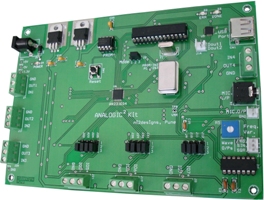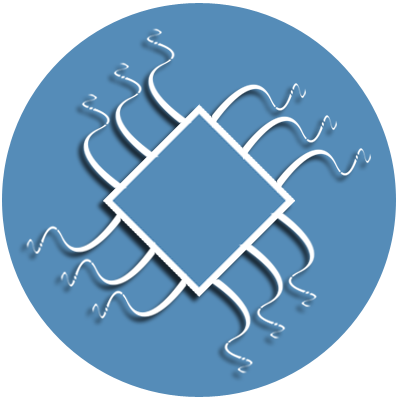ANALOGIC2

Field Programmable Analog Arrays (FPAAs) and its design software has introduced two new capabilities to the analog world. The first is the ability to translate complex analog circuits to a simple set of low-level functions, and thus to give designers the analog equivalent of an FPGA. The second is the ability to place analog functions under real-time software control within the system.
...and analog will never be the same again.
ni2designs presents a unique development board, ANALOGIC (ver 2) , for prototyping analog based designs using dynamically programmable Analog Signal Processor (dpASP).
By providing the analog equivalent of logic gates, dpASP offers designers the ability to describe analog functions such as gain stages and filters without referring to the underlying function - in other words, without having to think on the level of such components as op amps, capacitors, resistors, transconductors, and current mirrors. Lifted to this higher level of abstraction, the design process becomes so simple that non-specialists can create sophisticated circuits that would require weeks or months of design work with ASICs or discrete components.
Dynamically Programmable Analog Signal Processor (dpASP) or Field Programmable Analog Arrays (FPAA) and its design software has introduced two new capabilities to the analog world. The first is the ability to translate complex analog circuits to a simple set of low level functions, and thus to give designers the analog equivalent of a FPGA. The second is the ability to place analog functions under real-time software control within the system.
ANALOGIC 2 Protoboard Features
- dpASP AN231E04 based configurable analog design development board.
- Dynamically reconfigurable through plug & play USB port.
- Compatible to AnadigmDesigner®2 software with USB interface for downloading of design.
- Static reconfiguration with SPI EPROM.
- Supplied with SPI PROM programmer with RS-232 interface.
- Analog interface blocks (7 nos) for level-shifting, attenuating, filtering, etc.
- 4 dedicated input or output blocks with separate input & output ports.
- 3 pairs of input or output blocks with jumper selection for direction.
- High speed/precision OPAMPs used for signal conversion for every input/output block.
- Terminal screw headers for easy interface.
- Microphone jack port with on board amplifier.
- Microphone output header for amplified output.
- Onboard analog function generator
- 3 waves Sine, Square, Triangular waves @ 1Vpp
- Onboard potentiometer to vary frequency from Hz to KHz range
- Facility to change passive components for varying frequency ranges
- Configuration reset button.
- Onboard PIC microcontroller for programming and PC interface.
- LED indication for successful programming & error.
- LED indication for power supply.
- On-board 16-MHz oscillator module. Facility to change frequency ranges easily.
- +9V Power supply adapter.
- On board regulators for 3.3V and 5V supply with PCB as heat sink.
- Small & ergonomic design of board.
- Comes in attractive enclosure.
- Printed user manual
- Complete reference manual for using board with chapters on getting started, installing USB drivers, using Anadigm software, developing VC++ prototypes, etc
- CD-ROM with drivers, Anadigm software, PROM programmer and lots of ready to use examples.
Highlighted Features of dpASP AN231E04:
- Dynamic reconfiguration
- 7 configurable I/O cells, two dedicated output cells
- Fully differential architecture
- I/O buffering with single ended to differential conversion
- Low input offset through chopper stabilized amplifiers
- 256 Byte Look-Up Table (LUT) for linearization and arbitrary signal generation
- Typical Signal Bandwidth: DC-2MHz (Bandwidth is CAM dependent)
- Signal to Noise Ratio
- Broadband 90dB
- Narrowband (audio) 120dB
- Typical Signal Bandwidth: DC-2MHz (Bandwidth is CAM dependent)
- Total Harmonic Distortion (THD): 100dB
- User controlled Compensated low DC offset
- DC Offset via chopper stabilized architecture <50uV
- Package: 44-pin QFN
- Supply voltage: 3.3V
Typical Analog Applications by ANALOGIC Protoboard:
ANALOGIC Protoboard has wide application in diverse fields like Audio, Telecom, Signal Conditioning Systems, Control Systems, Industrial Systems, RFIDs, Medical, etc.
Some typical applications provided by ANALOGIC board are listed below:
- Active speaker crossovers.
- Speaker time alignment and phase correction Preamplifier gain stages and filtering.
- Music Synthesis.
- Data Acquisition.
- Industrial Controls.
- PID Control Loops.
- Programmable Analog Front-end.
- Adaptive DSP Dront-end.
- Instrumentation Analog Front-end.
- Complex Filtering.
- Adaptive Filtering and Control.
- Programmable gain Carrier Frequency Generation(25 kHz) for RFID.
- Carrier Modulation /Demodulation (FSK, AM, PSK,ASK).
- Adaptive Measurements for Military/Aerospace.
- Real-time Software Control of Analog System Peripherals.
- Adaptive Industrial Control and Automation.
- Stable Sensor Stimulus.
- Intelligent Sensors.
- Sensor Signal Conditioning.
- Self-Calibrating systems.
- Compensation for aging of System Components.
- Dynamic Recalibration of Remote Systems.
- Ultra-low Frequency Signal Conditioning.
- Custom Analog Signal Processing.
Benefits of dpASP Design Technology:
- Simplify Analog Design and Implementation.
- Fully documented, repeatable analog design
- Reconfiguration reduces design risk and allows field updates
- Platform-based design approach.
- Consolidate the manufacturing of multiple boards – by merely using a different configuration file
- Consolidate of multiple discrete components on a board.
- Reduce board space
- Simplify manufacturing
- Reduce inventory sourcing and management costs
- Increase system reliability and MTBF
- High-precision, drift-free operation.
- Dynamic reconfiguration allows for truly innovative analog systems design.





